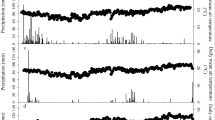Abstract
This study monitored deposition and decomposition of cattle dung in a grazed young Chamaecyparis obtusa (an evergreen conifer) plantation in southwestern Japan, as a part of exploring the impacts of livestock in the forest grazing system. Animals defecated 10–19 times hd−1 day−1, producing feces of 2.2–3.5 kg DM and 33–73 g N per animal per day. The DM and N concentrations of feces ranged from 157–207 g DM kg−1 and 14.8−23.1 g (kg DM)−1, respectively. Occurrence of defecation was spatially heterogeneous, with feces being concentrated mainly on areas for resting (forest roads, ridges and valleys) and moving (forest roads and along fence lines). Decomposition of dung pats was considerably slow, showing the rates of 1.37–3.05 mg DM (g DM)−1 day−1 as DM loss. Decomposition was further slower on the basis of N release, 0.51–1.63 mg N (g N)−1 day−1, resulting in steadily increased N concentrations of dung pats with time after deposition. The results show that introduction of livestock into a forest (i.e., forest grazing) may limit nutrient availability to plants, by redistributing nutrients into areas with no vegetation (bare land and streams) and by establishing a large N pool as feces due to an imbalance between deposition and slow release, though further studies are necessary for investigating the occurrence of slow dung decomposition in other forest situations.







Similar content being viewed by others
References
AOAC (1984) Official methods of analysis of the Association of Official Analytical Chemists, 14th edn. Association of Official Analytical Chemists, Washington, DC
Arnold GW, Dudzinski ML (1978) Ethology of free-ranging domestic animals. Elsevier, Amsterdam
Chowdappa R (2006) Grazing behavior and rumen characteristics of Japanese Black cattle in young forest and native grassland. PhD Thesis, The United Graduate School of Agricultural Sciences, Kagoshima University, Kagoshima
Chowdappa R, Hasegawa N, Goto M, Kozono M, Fujishiro T, Takahashi T, Takagi M, Nogami K, Sonoda T (2005) Behavior and ruminal characteristics of Japanese Black cattle grazing in forest of young tree plantation and native grassland. Anim Behav Manag 41:149–156
Franzluebbers AJ, Stuedemann JA, Schomberg HH (2000) Spatial distribution of soil carbon and nitrogen pools under grazed tall fescue. Soil Sci Soc Am J 64:635–639
Hayakawa Y, Sato Y, Miyashita A (1968) Studies on the character and management of permanent pasture. Part II. Productivity and fluctuation of the soil fertility under differential animals. Res Bull Hokkaido Natl Agric Exp Stn 93:67–77 (in Japanese with English summary)
Hirata M, Higashiyama M (1997) Spatial distribution of urination by cattle in a daytime grazing system. Asian–Australas J Anim Sci 10:484–490
Hirata M, Sugimoto Y, Ueno M (1988) Effects of cattle dung deposition on energy and matter flows in bahiagrass (Paspalum notatum Flügge) pasture. I. Changes in sward height and consumed herbage as related to rate of dung disappearance. J Jpn Grassl Sci 33:371–386
Hirata M, Sugimoto Y, Ueno M (1990) Return of dung to bahiagrass (Paspalum notatum Flügge) pasture by dairy cattle. J Jpn Soc Grassl Sci 35:350–357
Hirata M, Ogura S, Fukuyama K, Kuroki S, Inoue T, Hidaka T, Yuge T, Takahashi M, Nomura K (2003) Herbage production and utilization in a bahiagrass (Paspalum notatum Flügge) pasture grazed by breeding beef cows. Grassl Sci 48:477–484
Hirata M, Hasegawa N, Nogami K, Sonoda T (2007a) Tuft, shoot and leaf dynamics in Miscanthus sinensis in a young tree plantation under cattle grazing. Trop Grassl 41:113–128
Hirata M, Hasegawa N, Nogami K, Sonoda T (2007b) Evaluation of forest grazing as a management practice to utilize and control Miscanthus sinensis in a young tree plantation in southern Kyushu, Japan. Grassl Sci 53:181–191
MacDiarmid BN, Watkin BR (1972) The cattle dung patch. 2. Effect of a dung patch on the chemical status of the soil, and ammonia nitrogen losses from the patch. J Br Grassl Soc 27:43–48
Marsh R, Campling RC (1970) Fouling of pastures by dung. Herb Abstr 40:123–130
Moe SR, Wegge P (2008) Effects of deposition of deer dung on nutrient redistribution and on soil and plant nutrients on intensively grazed grasslands in lowland Nepal. Ecol Res 23:227–234
Nakamura Y (1975) Decomposition of organic materials and soil fauna in pasture. 2. Disappearance of cow dung. Pedobiologia 15:129–132
Nitta T, Sawada Y (1977) Microbial populations in grassland soil in relation to the decomposition of cattle dung. Bull Natl Grassl Res Inst 11:26–33 (in Japanese with English summary)
Nogami K, Muramoto Y, Nakagawa M (1993) Grazed plants by Wagyu cattle and weeding of Miscanthus sinensis by grazing in young Cryptomeria japonica and Chamaecyparis obtusa plantation. Bull Fac Agric, Miyazaki Univ 40:113–119 (in Japanese with English summary)
Omaliko CPE (1981) Dung deposition, breakdown and grazing behavior of beef cattle at two seasons in a tropical grassland ecosystem. J Range Manage 34:360–362
Scholes RJ, Walker BH (1993) An African savanna: synthesis of the Nylsvley study. Cambridge University Press, Cambridge
Sharrow SH, Ismail S (2004) Carbon and nitrogen storage in agroforests, tree plantations, and pastures in western Oregon, USA. Agrofor Syst 60:123–130
Sugimoto Y, Hirata M, Ueno M (1991) Effects of cattle dung deposition on energy and matter flows in bahiagrass (Paspalum notatum Flügge) pasture. V. Nitrogen flow. J Jpn Grassl Sci 36:376–383 (in Japanese with English summary)
Takagi M, Sugimoto Y (2006) Nitrogen concentration of streams from small basins with young plantation under cattle grazing. Jpn J Grassl Sci 51:369–373 (in Japanese with English summary)
Acknowledgments
We thank T. Iwamoto, Y. Kanda, D. Kiyota, N. Nakashima, N. Okada, W. Otozu, M. Furuse, N. Ozaki, R. Sato, T. Shiokawa, H. Yasuda, H. Hasegawa, Y. Nagakura, S. Gondo, T. Takahashi, R. Chowdappa and S. Ogura for assistance in field measurements and M. Takagi, Tano Forest Science Station, for providing the map of the study site.
Author information
Authors and Affiliations
Corresponding author
About this article
Cite this article
Hirata, M., Hasegawa, N., Nomura, M. et al. Deposition and decomposition of cattle dung in forest grazing in southern Kyushu, Japan. Ecol Res 24, 119–125 (2009). https://doi.org/10.1007/s11284-008-0488-y
Received:
Accepted:
Published:
Issue Date:
DOI: https://doi.org/10.1007/s11284-008-0488-y




